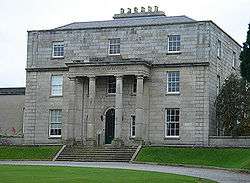Richard Moore (Irish lawyer)
Richard Moore PC (1783 – 31 December 1857) was an Irish lawyer and judge.

Background
He was born near Clonmel, County Tipperary, second son of Stephen Moore of Salisbury House.[1] The Moores of Clonmel were a junior branch of the landowning family whose senior branch acquired the title Earl Mount Cashell.
Family
Richard married firstly Frances Bligh, by whom he had a son Richard; and secondly Wilhelmina Westby, by who he had a son William and a daughter Frances.[2]
Early career
He was educated at the University of Dublin, where he took his Bachelor of Arts degree in 1803, entered the Middle Temple in 1804, was called to the Irish Bar in 1806 and became King's Counsel in 1827.[3] He became Third Serjeant, a Bencher of the King's Inn, and Solicitor General for Ireland in 1840.[4] Though he supported the Liberals, Elrington Ball states that he was not much interested in politics.[5]
Later career
Moore was Attorney-General for Ireland during part of Lord John Russell's Whig Government 1846-1852, holding that office from 16 July 1846 to 21 December 1847.[6] He was then appointed as a judge of the Court of Queen's Bench (Ireland) and remained a judge until his death.[7] He was one of the Special Commission judges appointed for the trial in which William Smith O'Brien was convicted of high treason for his part in the Young Irelander Rebellion of 1848 (The Queen v O'Brien (1849) 3 Cox CC 360). O'Brien's death sentence was commuted to one of transportation and he received an unconditional pardon in 1856, after which he returned to Ireland.
Reputation
Ball states that Moore was universally respected for his legal ability, notwithstanding a certain modesty and diffidence about his own talents.[8] An anonymous pamphlet from 1850, which was critical of many members of the Irish Bench, had high praise for More's legal intellect.[9]
St. Enda's School
From 1840 until his death Moore lived in Rathfarnham, Dublin. His house, the Hermitage, later became St. Enda's School, the secondary school for boys founded by Padraic Pearse. The house and grounds have been owned by the State since 1968 and the house is now the Pearse Museum[10]
References
- Ball, F. Elrington The Judges in Ireland 1221-1921 John Murray London 1926 Vol.ii p.357
- Ball pp.357-8
- Hart, A.R. History of the King's Serjeants-at-law in Ireland Four Courts Press Dublin 2000 p.177
- Hart p.177
- Ball p.295
- Hart p.177
- Hart p.177
- Ball p.292
- Ball p.295
- Healy (2004) p 197.
- Doheny, Michael (1914). The Felon's Track. Dublin: M.H. Gill & Son. (available at Project Gutenberg )
- Healy, Paddy (2004). Archaeology, Early Christian remains and local histories: Paddy Healy's Dublin. Dublin: South Dublin Libraries. ISBN 0-9547660-1-6. (available at http://www.southdublinlibraries.ie)
| Legal offices | ||
|---|---|---|
| Preceded by David Richard Pigot |
Solicitor-General for Ireland 1840–1841 |
Succeeded by Edward Pennefather |
| Preceded by Richard Wilson Greene |
Attorney-General for Ireland 1846–1847 |
Succeeded by James Henry Monahan |